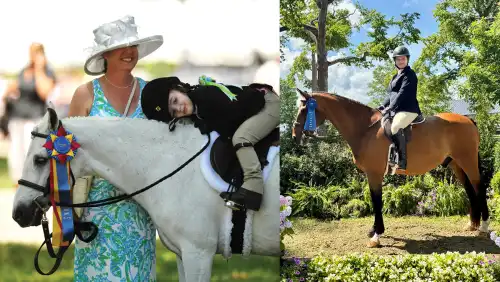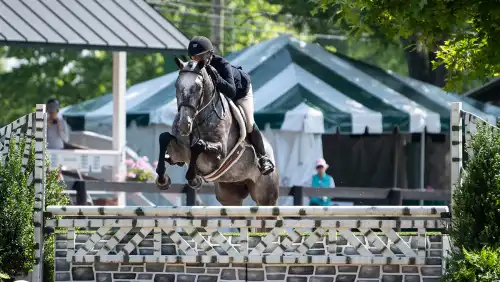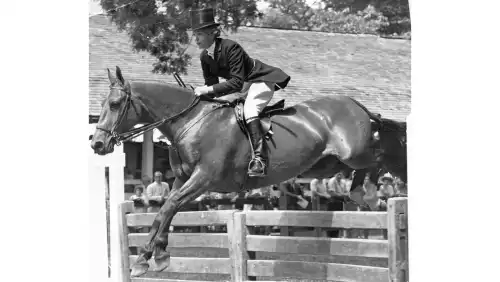Saugerties, N.Y.—Sept. 9
As I drove from the HITS-on-the-Hudson showgrounds to the Albany airport, I passed through a furious rain shower. Then, an intensely vivid rainbow appeared. But it was a bit too late—an hour before, McLain Ward had picked up the pot of gold.
With the only double clear of the Pfizer $1 Million Grand Prix on Antares F, Ward triumphed over the richest grand prix in the United States. He earned $350,000 for Antares’ owners, Grant Road Partners.
“We’re not afraid to write checks,” said HITS President Tom Struzzieri. And that’s an understatement. HITS gave out $1.75 million in prize money on Sept. 9 between the grand prix and two hunter prixs. Patricia Griffith won the $500,000 Diamond Mills Hunter Prix on Sienna, and amateur rider Chiara Parlagreco topped the $250,000 HITS Hunter Prix on The Impressionist. It’s a staggering amount of prize money.
And Jill Henselwood and Jonanthan McCrea, who had to jump off with Ward for that pot of gold, knew just what they were in for. Ward jumped off first with Antares and laid down a fast, clean trip in 39.87 seconds. “With McLain in the jump-off, I figured I could skip a jump and still be slower. He’s the fastest rider there is, and the horse is experienced. It was going to be hard to catch,” McCrea said. He tried, but on the way Colorado felled two rails. With 8 faults, they claimed third (which was still worth a hefty $120,00 payout!).
Henselwood, a Canadian Olympic veteran, didn’t have much choice. “I know how fast McLain is, and I know my horse jumps too high and actually is a little inexperienced in jump-offs, period. But, I still had to try!” she said. “So, I set off as fast as I thought I could, and I think by the second jump I was already too slow. But I didn’t stop trying until I had the rail. I knew Jonathan had had a bit of bad luck, and so I just settled down and prayed I didn’t have another rail.” She didn’t, and the 4 faults was good enough for second place and $200,000 in prize money.
George Is A Bit ADHD
ADVERTISEMENT
For Henselwood, George’s performance was heartening. The big chestnut is just 10 and was dead green when Henselwood started riding him three years ago. She had to accelerate his development to help the Canadian team at the 2011 Pan American Games, and again for the 2012 London Olympic Games.
“I was continuing to run with my program to try and grow his experiences, get him to enough big classes, but not scare him. It’s been a real uphill climb to get him to the Olympic level,” Henselwood said.
“When I got him [to the London Olympic Games for the Canadian team], I was a little afraid. I was afraid it was going to be too hard given what he knew. I said that to my team and said that if they wanted the alternate to ride, I’d be happy with that. But they said they believed in George. He actually peaked there. He brought the experiences he had, the skills he had, and I thought he jumped the best of his whole career yet at the Games—until today! I think he jumped even better today than at the Olympic Games. He walked into a new venue and solved it first crack; that’s a first for him at this level, to walk in and deliver. I was very proud of him.”
Henselwood giggles a bit when she says, “He’s a character,” about George. The enthusiastic gelding is a bit all over the place in the ring and drew gasps from the crowd for his massive efforts over the jumps. “He has probably as much scope as any horse in the world. He’s an unbelievable jumper, but I don’t know that he really gives a lot of thought to what he does,” Henselwood said.
“He walked into the ring today and right away went sideways when he saw the little pools that were decoration. He loses his attention at things that the course designers build as decoration. Beautiful islands built for the aesthetics cause some problems for George,” she continued. “I don’t quite know what he thinks! But once he concentrates on the jump, he’s going to jump. He puts so much effort it. There’s so much air between him and the rails that it’s a little hard to sit, and it’s a little hard to get under the time allowed. That’s my biggest challenge with him.”
For Some, The Course Won
Given the payout, it was easy to raise an eyebrow a bit when you looked down the starting list for the Pfizer $1 Million Grand Prix. There were quite a few combinations that were new to this level of competition, intermixed with some seasoned veterans. But course designer Olaf Petersen Jr., admitted that he didn’t build to the field. “I was looking at the prize money. I don’t like when someone wins this level of class who has a less-than-scopey horse or cannot solve the technical questions that I ask,” Petersen said. “It’s difficult, because the quality of the field was very varied. Some qualified from 1.45-meter grand prix classes. Then, going to 1.55- and 1.60-meter jumps, that is a really tough thing.”
ADVERTISEMENT
Ward made it look easy, going third in the order since he was a wild-card entry. (The order of go was run in reverse order of the riders’ standings on the qualification list.) But it quickly became obvious that it was far from easy. “I think the course was hard. There were some big jumps out there. The triple was a real five-star competition combination, and you needed a real Olympic-caliber horse to jump it well,” said Ward.
Interestingly enough, two of the three riders in the jump-off had gotten wild-cards for the class—Ward and McCrea. Henselwood had qualified for the class on another horse, coming in 12th in the standings, but chose to compete on George.
When the dust cleared, five riders had hit the ground in the ring. A few came off when their horses refused, and some were catapulted to the ground when a back rail became impossible for their horse, and they swam through a jump. John Pearce toppled off Chianto over the C element of the triple combination in a scary looking fall but walked out of the ring waving. it was a bit difficult to watch and not necessarily the image of the sport that spectators signed up to see.
Jeffery Welles was eliminated when Aries said “no” to jumping twice early in the course. And three other riders retired on course after running into problems. Six riders accumulated scores over 20 faults. “It was maybe a little bit too challenging for some of the riders,” said Struzzieri. “That, I thought, was unfortunate, because my goal is to grow the sport. That was the only thing I was disappointed in, that so many riders had a bad experience today.”
When asked if he’s going to rethink the qualifications for the million-dollar class, Struzzieri nodded thoughtfully. “We’re going to look hard at how we run this class next year. I’m not quite sure how we’ll do that,” he said. For this year, riders had to qualify by jumping at designated grand prix classes at HITS venues across the country—Ocala, Fla., Thermal, Calif., Saugerties, and Culpeper, Va.














